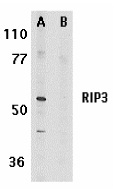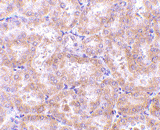RIP3 antibody


Rabbit anti RIP3
- Product Type
- Polyclonal Antibody
- Isotype
- Polyclonal IgG
- Specificity
- RIP3
| Rabbit anti RIP3 antibody recognizes mouse serine-threonine kinase receptor-interacting protein 3 (RIP3). RIP3 is related to RIP and RIP2 but does not posses a death domain or CARD motif at its C-terminus. RIP3 activates NF-Kappa B and potently induces apoptosis. RIP3 is expressed in a range of tissues including the spleen, liver, testis, heart, brain and lung. |
- Target Species
- Mouse
- Species Cross-Reactivity
-
Target Species Cross Reactivity Rat - N.B. Antibody reactivity and working conditions may vary between species.
- Product Form
- Purified IgG - liquid
- Antiserum Preparation
- Antisera to mouse RIP3 were raised by repeated immunisation of rabbits with highly purified antigen. Purified IgG prepared from whole serum by affinity chromatography.
- Buffer Solution
- Phosphate buffered saline
- Preservative Stabilisers
- 0.02% Sodium Azide (NaN3)
- Immunogen
- Synthetic peptide sequence corresponding to amino acids 473-486 of mouse RIP3.
- Approx. Protein Concentrations
- IgG concentration 1.0mg/ml
- Regulatory
- For research purposes only
- Guarantee
- 12 months from date of despatch
Avoid repeated freezing and thawing as this may denature the antibody. Storage in frost-free freezers is not recommended.
| Application Name | Verified | Min Dilution | Max Dilution |
|---|---|---|---|
| Immunohistology - Paraffin 1 | 5ug/ml | ||
| Western Blotting | 0.5 | 1.0ug/ml |
- 1This product requires antigen retrieval using heat treatment prior to staining of paraffin sections.Sodium citrate buffer pH 6.0 is recommended for this purpose.
- Histology Positive Control Tissue
- Rat kidney
- Western Blotting
- AHP1797 detects a band of approximately 56 kDa in Mouse 3T3 whole cell lysate
| Description | Product Code | Applications | Pack Size | List Price | Your Price | Quantity | |
|---|---|---|---|---|---|---|---|
| Antigen Retrieval Buffer, pH8.0 | BUF025A | P | 500 ml | Log in | |||
| List Price | Your Price | ||||||
| Log in | |||||||
| Description | Antigen Retrieval Buffer, pH8.0 | ||||||
| TidyBlot Western Blot Detection Reagent:HRP | STAR209P | WB * | 0.5 ml | Log in | |||
| List Price | Your Price | ||||||
| Log in | |||||||
| Description | TidyBlot Western Blot Detection Reagent:HRP | ||||||
References for RIP3 antibody
-
Feng, S. et al. (2007) Cleavage of RIP3 inactivates its caspase-independent apoptosis pathway by removal of kinase domain.
Cell Signal. 19 (10): 2056-67. -
Günther, C. et al. (2011) Caspase-8 regulates TNF-α-induced epithelial necroptosis and terminal ileitis.
Nature. 477: 335-9. -
Mizumura, K. et al. (2014) Mitophagy-dependent necroptosis contributes to the pathogenesis of COPD.
J Clin Invest. 124 (9): 3987-4003. -
Huang, S.C. et al. (2014) Tumor necrosis factor suppresses NR5A2 activity and intestinal glucocorticoid synthesis to sustain chronic colitis.
Sci Signal. 7 (314): ra20. -
Meng, L. et al. (2015) RIP3-mediated necrotic cell death accelerates systematic inflammation and mortality.
Proc Natl Acad Sci U S A. 112 (35): 11007-12. -
Mizumura, K. et al. (2018) Sphingolipid regulation of lung epithelial cell mitophagy and necroptosis during cigarette smoke exposure.
FASEB J. 32 (4): 1880-90. -
Najafov, A. et al. (2019) TAM Kinases Promote Necroptosis by Regulating Oligomerization of MLKL.
Mol Cell. 75 (3): 457-468.e4. -
Matsuzawa-Ishimoto, Y. et al. (2022) The γδ IEL effector API5 masks genetic susceptibility to Paneth cell death.
Nature. 610 (7932): 547-54.
View The Latest Product References
Further Reading
-
Yu, P.W. et al. (1999) Identification of RIP3, a RIP-like kinase that activates apoptosis and NFkappaB.
Curr Biol. 9 (10): 539-42. -
Sun, X., et al (1999) RIP3, a novel apoptosis-inducing kinase.
J Biol Chem. 274:16871-5. -
Pazdernik, N.J., et al (1999) Mouse receptor interacting protein 3 does not contain a caspase-recruiting or a death domain but induces apoptosis and activates NF-κB.
Mol Cell Bio.19:6500-8
- RRID
- AB_2178676
- UniProt
- Q9QZL0
- Entrez Gene
- Ripk3
- GO Terms
- GO:0005515 protein binding
- GO:0006915 apoptosis
- GO:0004704 NF-kappaB-inducing kinase activity
- GO:0005524 ATP binding
- GO:0005737 cytoplasm
- GO:0006468 protein phosphorylation
- GO:0006917 induction of apoptosis
- GO:0007249 I-kappaB kinase/NF-kappaB cascade
Please Note: All Products are "FOR RESEARCH PURPOSES ONLY"
View all Anti-Mouse ProductsAlways be the first to know.
When we launch new products and resources to help you achieve more in the lab.
Yes, sign me up
